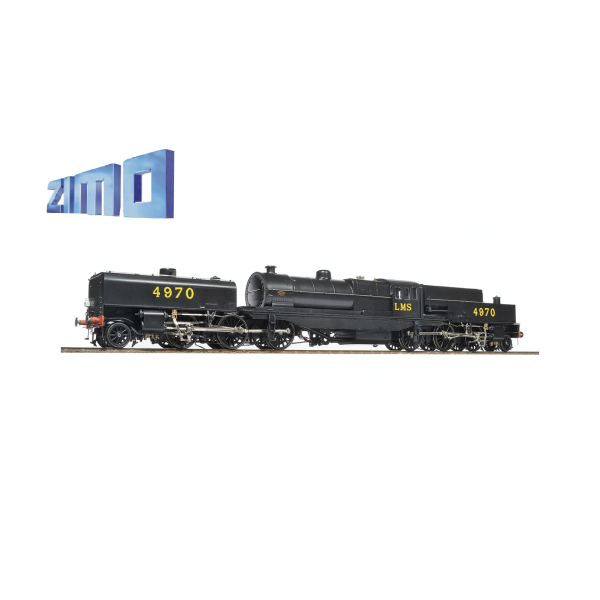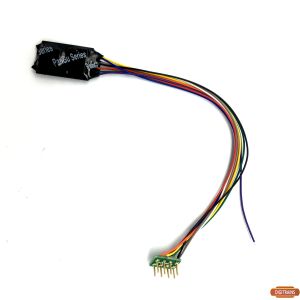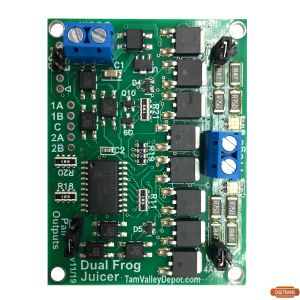Digitrains ZS024A Beyer-Garratt ZIMO sound project V15.1 with Active braking control by Paul Chetter.
Thank you for choosing Digitrains; we try harder to provide you with the very best sound projects available.
Please spend a few moments to read these notes which have been produced so that you may obtain the maximum satisfaction from your new sound scheme.
The sounds should work perfectly when the decoder is fitted correctly. Individual locos may require some fine tuning that you can achieve with your DCC controller.
Operating Your ZIMO Sound Decoder.
As supplied, your new decoder will work in a ‘heavy train’ configuration, but you will be able to switch between the available sounds using your DCC controller by following the straightforward instructions below.
This project utilises Zimo’s ability to switch between the sounds of a heavy train load or sounds of a light engine.
These are all fully configured within the project, waiting for you to make your choice.
You can revert back at any time.
All the CVs have been optimised for the Heljan Beyer Garratt but you may need to make minor adjustments to perfect it for your individual model
There are more than 20 Functions, most of which have an individual sound attached. Some will perform a physical function (like turning on the lamps, if fitted), and some will do both (depending on equipment installed). Please study the list below.
Some of the sounds have a finite length and will play from start to finish when selected. Other sounds will ‘loop’ until switched off, whilst others will vary in length, depending on how you operate the F keys on your DCC controller. I’ll leave you with the pleasure of finding out which is which.
In any of the driving sound sets, increasing the speed step by 1 will produce an acceleration sound for a few seconds. If you wish continuous acceleration, ease the throttle setting upwards rather than 0- 128 in one jump!
Similarly, in each sound set, a reduction of 1 speed step will stop the exhaust beats and the loco will ‘coast’ (or drift) for a few seconds before resuming exhaust beats. Continuous drifting can be simulated by easing the throttle settings down, one step at a time.
All sounds may be modified (including changing or removing them) individually, and the volume levels of each one may also be varied to your own needs. For this, and much more information on your decoder’s outstanding abilities, please download the latest Decoder Manual from: www.zimo.at/web2010/
You can get advice in English by joining, for free: [email protected]
Heavy Mode
This is the default setting. Inertia and momentum have high settings to reflect the high mass of a loaded train. Maximum power would be required on a real loco to lift a heavy train. This means that as well as opening the regulator, the driver would allow maximum steam into the cylinders with the reverser fully open.
During acceleration, the exhaust beats will bark aggressively, but the tone and volume will soften after a few seconds as the real driver would advance the steam cut-off to reduce steam entering the cylinders, increasing the efficiency of the engine.
Light Engine Mode F5
Engaging F5 will lower the inertia and momentum settings on the decoder mimicking a light engine with no train to pull.
Dynamic Inertia
In either Heavy or Light modes, flipping the throttle quickly to high speed steps will cause the model to accelerate 3 times more quickly from standing than if the throttle is gradually opened. This is automatic, no F keys are involved.
So now, the rate of acceleration is determined by how wide you open the regulator, just as it would on a real locomotive.
Real Brakes
F2 will give the sound of steam brake applications. F2 can be ‘dabbed’ or held for varying durations and the sound will respond accordingly. However, if the throttle is closed first, as a real driver would do before braking, the loco will go into coasting and lose speed only very gradually. Upon pressing F2 an actual braking effect will be applied which will continue to increase the longer F2 is held. Short dabs will provide speed trimming, held down continuously will result in a controlled ‘Emergency Stop’. F2 is used because it is most commonly non-latching function on many DCC system controllers and can therefore be used like a brake control handle in a real loco cab. If the throttle is backed off but not closed the braking effect will work only down the the speed still set on the throttle and your loco will not come to a complete stop.
If this all seems a step too far then the decoder’s momentum settings can be reduced to your taste by lowering the value in CV 4. this will restore a more familiar feel to your driving experience and the loco will slow on the throttle on the normal way rather than needing real brake applications to be made.
Shunt Mode
Inertia and momentum are reduced to zero plus speed is halved.
Shunt mode in on F Key 20:
Live Volume Control
Provide the sound is switched on and the ‘fade’ button is not active, it is possible to change the overall volume to suit changing needs.
Engage F27 and the sound levels will gradually reduce, eventually to silence
Engage F28 and the sound levels will gradually increase, eventually to maximum.
In each case, disengage the F key when the desired level is attained. Set F27 and F28 as ‘momentary’ if your DCC controller allows you to do so.
Note: If the volume controls appear to not function, check that F19, F27 and F28 are disengaged before making a further attempt.
Function Keys List
F0 – Loco Lamps (If Fitted)
F1 - Sound on/sound off
F2 – Brake Key – see text for explanation
F3 – Long Single Whistle
F4 – Toot Whistle
F5 – Heavy Train/Light Engine selection
F6 – Coal shovelling. (Plus firebox flicker if fitted) (This sound is also a random sound)
F7 – Injector (This sound is also a random sound when standing)
F8 – Blower (This sound is also a random sound when standing)
F9 – Wheel Flange (Hold key to extend duration)
F10 – Buffering up
F11 – Coupling
F12 – Oscillating Self-trimming Bunker (Hold key to extend duration)
F13 – Safety valves lifted
F14 – Whistle
F15 – Cylinder Drain Cocks Open
F16 – Wagons Taking Up Coupling Slack
F17 – Tender Watertank Filling (Hold key to extend duration)
F18 – Guard’s Whistle
F19 – Fade all sounds
F20 – Shunt Mode
F21 - Reserved
F22 – Reserved
F23 – Reserved
F24 – Reserved
F25 – Reserved
F26 – Reserved
F27 – Volume Reduction
F28 – Volume Increase.





